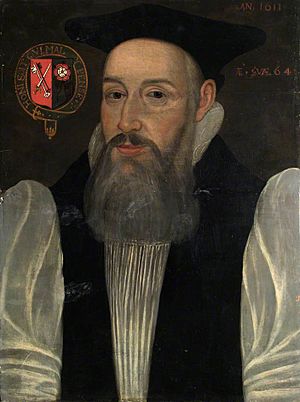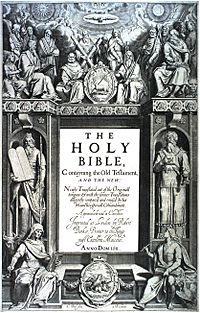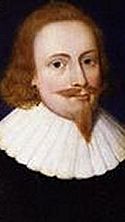Thomas Bilson facts for kids
Quick facts for kids The Right Reverend and Right Honourable Thomas Bilson |
|
|---|---|
| Lord Bishop of Winchester | |
 |
|
| Province | Church of England |
| See | Winchester |
| Enthroned | 1597 |
| Predecessor | William Day |
| Successor | James Montague |
| Other posts | Bishop of Worcester (1596–1597) |
| Personal details | |
| Born | 1547 Winchester, England |
| Died | 18 June 1616 |
Thomas Bilson (1547 – 18 June 1616) was an important leader in the Church of England. He served as a Bishop of Worcester and later as the Bishop of Winchester. He is well-known for working with Miles Smith to complete and print the famous King James Bible.
Contents
Thomas Bilson's Early Life and Education
Thomas Bilson was born in Winchester, England, in 1547. His father, Harmann Bilson, had family roots in Germany. Thomas was one of six children.
He went to two famous schools founded by William of Wykeham: Winchester College and New College, Oxford. He studied at New College from 1563 to 1572. He first enjoyed writing poetry, but after becoming a priest, he focused entirely on studying theology. He earned advanced degrees in theology in 1579 and 1580/81.
Becoming a Church Leader
Bilson quickly rose through the ranks in the church. He became a church official (called a prebendary) in Winchester. He also served as headmaster of Winchester College until 1579 and then as its warden (a senior leader) from 1581 to 1596. Some of his students included John Owen and Thomas James.
In 1596, he was made Bishop of Worcester. This area had many people who secretly practiced Roman Catholicism, which was against the law at the time. In 1597, he became the Bishop of Winchester, a very important and wealthy position.
Bilson's Important Writings
Thomas Bilson was a strong supporter of the Church of England. He often took part in debates of his time.
What Was The True Difference?
In 1585, Bilson published a book called The True Difference Betweene Christian Subjection and Unchristian Rebellion. He dedicated this book to Queen Elizabeth I. The book was written to challenge the ideas of Jesuits and to respond to a book by Cardinal William Allen.
This book also explored ideas about how a Christian country should be governed. It became quite popular. Some people believed Queen Elizabeth asked Bilson to write it. The book discussed when people might be allowed to go against their ruler, which was a very sensitive topic. Bilson tried to be careful in his writing, especially when talking about how people should view their monarch.
Bilson and London's Theatres
Winchester Palace was the official home of the Bishops of Winchester in London. It was a large building on the south side of the River Thames, in an area called Southwark. The bishops had some control over this area, which was also known as the "Liberty of the Clink" because it included a prison called "The Clink". Today, only one wall of the palace hall remains standing.
The Rise of Theatres in Southwark
Southwark became a popular place for entertainment. A businessman named Philip Henslowe helped build The Rose theatre in 1587. It was one of London's first big, permanent playhouses. Henslowe worked with famous acting groups like the Admiral's Men.
Later, other theatres were built in Southwark, including The Swan Theatre in 1596. In 1597, Thomas Bilson became Bishop of Winchester, meaning he had some authority over this area. In 1598, William Shakespeare's company, the Lord Chamberlain's Men, built the new Globe Theatre in the Clink Liberty. Henslowe continued to build more theatres, like the Hope Theatre in 1613.
Interestingly, records show that William Shakespeare owed money to the Bishop of Winchester in 1600. This might have been related to the Globe Theatre being in the bishop's area of control.
Serving King James I
When James VI and I became King of England in 1603, Thomas Bilson played an important role.
The King James Bible
Bilson gave the sermon at King James I's coronation on July 25, 1603. He spoke about the king's power but also mentioned when people might be allowed to resist a ruler. This idea came from his 1585 book.
At the Hampton Court Conference in 1604, Bilson and Richard Bancroft asked King James not to make too many changes to the Church of England. Bilson had actually advised the King not to hold the conference at all. Later, Bilson was put in charge of the Authorized Version of the Bible, known today as the King James Bible. He wrote the dedication and other introductory parts with Miles Smith.
Intervening at Oxford University
Bilson was also a special visitor for St John's College, Oxford. In 1611, he had to step in when there was a disagreement about who should be the new president of the college. The two main candidates were William Laud and John Rawlinson. Bilson eventually decided in favor of Laud, but only after some complicated events and the King's involvement.
Thomas Bilson's Final Years
In 1613, Bilson was asked to be a judge in a famous divorce case involving Robert Devereux, 3rd Earl of Essex and his wife Frances Howard. The original judges were stuck, so the King added Bilson and another bishop. This caused tension with the Archbishop of Canterbury, George Abbot, who felt Bilson was not fair. Bilson played a key part in the divorce being granted. His son, Sir Thomas Bilson, even got the nickname "Sir Nullity Bilson" because his knighthood followed this case.
In August 1615, Bilson became a member of the Privy Council, a group of advisors to the King. This was a high point in his career, helped by the King's favorite, Robert Carr, 1st Earl of Somerset. However, Somerset's pushiness on Bilson's behalf actually annoyed the King. This led to Somerset being replaced by George Villiers as the King's favorite.
Death and Burial
Thomas Bilson died in 1616. He was buried in Westminster Abbey, a very important church in London. His grave is near the tombs of King Richard II and King Edward III. A simple brass plate now marks his burial spot.
The inscription on his grave says:
Here lies Thomas Bilson, formerly bishop of Winchester and counsellor in sacred matters of his serene highness King James of Great Britain, who when he had served God and the church for nineteen years in the bishopric laid aside mortality in certain hope of resurrection 18 June 1616 aged 69.
Bilson did not leave a will. He was married to Anne, and they had two children:
- Sir Thomas Bilson (born 1591), who became a Member of Parliament for Winchester.
- Amy Bilson (born 1593), who married Sir Richard Norton, 1st Baronet.
Thomas Bilson's Legacy
People said that Bilson looked like a powerful church leader. Anthony à Wood, a historian, described him as very knowledgeable in theology and languages. He called Bilson a "commander in chief in the spiritual warfare."
Bilson was also known for being very strict against Roman Catholics who refused to follow the Church of England. His ideas about when it might be okay to resist a ruler, which he wrote about in 1585, were later used by others. For example, Richard Baxter used Bilson's arguments to support the removal of King James II a century later. Bilson's writings helped shape important discussions about power and religion in England.
Bilson's Main Books
Bilson's writings often took a balanced approach to church rules and government power. He believed people should obey authority, but he also discussed exceptions. His works include:
- The True Difference Betweene Christian Subjection and Unchristian Rebellion (1585)
- The Perpetual Government Of Christ's Church (1593)
- Survey of Christ's Sufferings for Man's Redemption and of His Descent to Hades Or Hell for Our Deliverance (1604)
|



